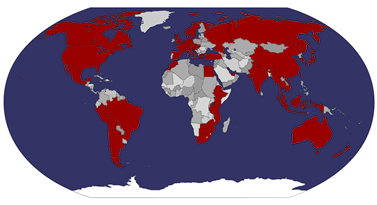To curb vice in others as well as in me,
I wonder we ha'nt better company
'Neath Tyburn Tree.
(John Gay, The Beggar's Opera)
The location of the Tyburn Tree has always been of some interest to me, but things came to a head when the Badger Passport question for the Mason's Arms (a fine pub if you're in the area) was "What was the pub used for in the eighteenth century?".
The answer was that prisoners would be held here, and possibly offered a last drink, before being led out to the Tyburn Tree to be hanged. Tyburn was the name of a village around the site of the present day Marble Arch. In fact from the map you can see the junction effectively as it is today, with Edgware Road heading NW from the junction. Edgware Road, aka the A5, runs along the original Watling Street road, stretching all the way to Holyhead in Wales!

There were eight hanging days a year at Tyburn, which were normally held on a Monday. The prisoners were held at Newgate Gaol in the City and at seven in the morning those whose time had come were placed in open carts and taken on a procession through St Giles in the Fields and down Oxford Street (or the Tyburn Road as it was at the time). The procession would stop at St Sepulchre's Church enroute, where the minister would call for repentance from and prayers for "whom the great bell tolls" as the church bells rang.

Here is the marker, which is on the traffic island in front of Odeon, at the beginning of Edgware Road. Message me if you need any further instructions, it's not especially easy to find - I've looked for it before and missed it!:

Here's how the "tree" looked, not being an actual tree at all of course:

From wiki:
The first recorded execution took place at a site next to the stream in 1196. William Fitz Osbern, the populist leader of the London tax riots was cornered in the church of St Mary le Bow. He was dragged naked behind a horse to Tyburn, where he was hanged.
In 1571, the "Tyburn Tree" was erected near the modern Marble Arch. The "Tree" or "Triple Tree" was a novel form of gallows, comprising a horizontal wooden triangle supported by three legs. Several felons could thus be hanged at once, and so the gallows was occasionally used for mass executions, such as that on June 23, 1649 when 24 prisoners – 23 men and one woman – were hanged simultaneously, having been conveyed there in eight carts.
The Tree stood in the middle of the roadway, providing a major landmark in west London and presenting a very obvious symbol of the law to travellers. After executions, the bodies would be buried nearby or in later times removed for dissection by anatomists.
The first victim of the "Tyburn Tree" was Dr John Story, a Roman Catholic who refused to recognize Elizabeth I. Among the more notable individuals suspended from the "Tree" in the following centuries were John Bradshaw, Henry Ireton and Oliver Cromwell, who were already dead; they were disinterred and hanged at Tyburn in January 1661 on the orders of Charles II in an act of posthumous revenge for their part in the beheading of his father.
The executions were public spectacles and proved extremely popular, attracting crowds of thousands. The enterprising villagers of Tyburn erected large spectator stands so that as many as possible could see the hangings (for a fee). On one occasion, the stands collapsed, reportedly killing and injuring hundreds of people. This did not prove a deterrent, however, and the executions continued to be treated as public holidays, with London apprentices being given the day off for them. One such event was depicted by William Hogarth in his satirical print, The Idle 'Prentice Executed at Tyburn (1747).
John Austin, a highwayman, was the last to be hanged here, on the 3 November 1783.
To me it seems a shame that the reference to the history on the ground is so obscure - let's have a mock gallows put up again! Marble Arch is a small arch stranded in a busy polluted traffic system. Back to the old theme - get rid of the traffic! Reclaim the streets!
N.B. the Tyburn River is one of the lost rivers I referred to in my last post - running from South Hampstead down to the Thames at Vauxhall, including the length of Marylebone Lane and through St James'. It is carried in pipes through Baker Street and Victoria Stations.
Incidentally I should confess that most of the background information for this entry, and photos (apart from mine of the marker stone which prompted the post) was pinched from Wikipedia and Everything2.




No comments:
Post a Comment